Brick tile: features and benefits
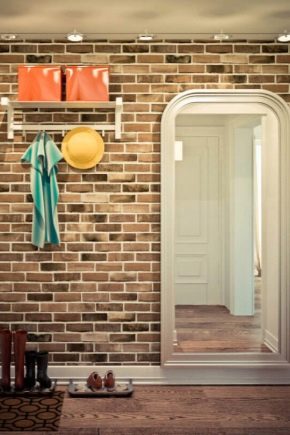
When planning the decoration of the premises, it is important to know that there are materials that are best used for outdoor work, and there are those that are used indoors. Brick tile is a versatile tool that is used both outside and inside the house.
Thanks to this decor, an amazing atmosphere is created, and a person feels like in a room with real brickwork.

Peculiarities
If you want to make your interior special, then it is important to use the available space correctly, filling it in such a way that it is pleasant and comfortable to be at home. In order to implement such an idea, you may need an interior novelty, which has been actively used in recent years to create an interesting image of the room.
Brick-like tiles can decorate both the inner space of the room and the outer walls of the building. Depending on where exactly the tiles will be used, they can be made of different materials. Imitation of a brick pattern allows you to organize the space, making the surfaces even and correct. Inside the house, you can most often find such masonry in the corridor, in the kitchen or in the bathroom.... It is in these rooms that it is important to protect the walls from the harmful effects of moisture.
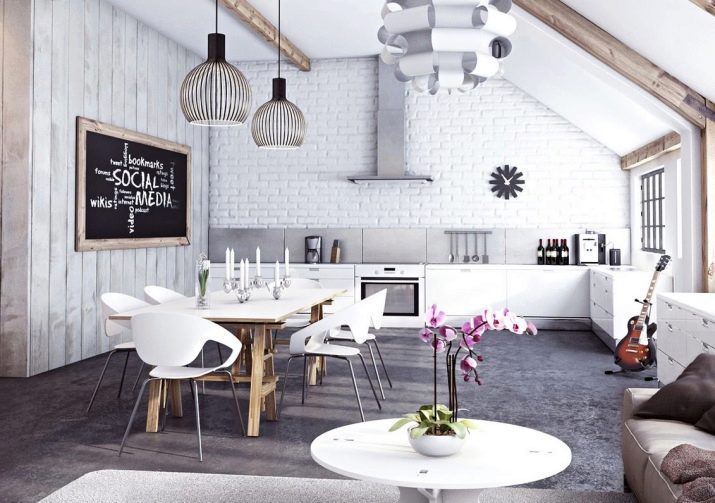





A tile imitating a real brick will look amazing on the facades, especially if the house is very old, and the facade coating is already crumbling. A little renovation work and your imagination - and the old house will take on a new life.
Among the advantages of such material are:
- environmental friendliness;
- the ability to use on different surfaces;
- long service life;
- soundproofing;
- moisture resistance.



The disadvantages include the duration of the work and the need to call the wizard. A real professional will cope with the work much faster, and the quality of the masonry will be at the highest level.
Of course, no one forces you to call the master. You yourself can put on your own tiles that imitate a brick wall. For this, it is important to know just a few nuances.

Types and characteristics
Depending on where exactly you plan to carry out the repair work, as well as where the decorative brick-like tiles will be placed, the choice of material and its texture will depend. When it comes to the kitchen or bathroom, then the advantage should be given to smooth surfaces. Glossy surface is easy to use and clean... Kitchen tiles can be made in various colors - it all depends on the style of your renovation.
Ceramic tiles work well in a bathroom where it is constantly humid and water often hits the surface of the walls. For those accustomed to the more standard look of such spaces, it is not necessary to use materials of this kind. Adherents of the classics will suit the tiled surface of the walls, which is in no way inferior, but has slightly different characteristics. They are mainly about size. If you choose a tile 20x30 cm, then you can lay it on the wall in a matter of days, even if the room is large.




For lovers of unusual design solutions and original appearance of housing, the best choice would be facing tiles from various materials. Brick texture can look exactly like real, and you can hardly tell the difference with the real material.
Instead of carefully laying out bricks to create the right atmosphere in the room, you can use an artificial variation of the stone. The advantage will be the convenience of working with tiles during installation.... Due to its small size, it is quite easy to evenly and correctly arrange all the elements on the wall, achieving an ideal result. Wall tiles can be textured, that is, have uneven edges and be as similar as possible to brick or stone.




For those who want to see smooth and even walls, it is best to use natural stone slabs, which look great both in the kitchen and in the bathroom.
Plastic tiles can be used in any room: in the kitchen - near the working area, in the corridor, it can be used to decorate most of the room, in the hall - a wall with a sofa or a fireplace area, if any. In the bedroom, it is recommended to abandon this option due to the fact that it does not set you up for relaxation and rest..
For lovers of something exclusive, hand-molded tiles, which can have a variety and the most bizarre man-made shapes, will suit. This can emphasize the style of your room, create its unique image.




Depending on the materials, such tiles can be used both indoors and as facade cladding.
Finishing work in this case will not be difficult, because the surface is uneven, and it is not necessary to lay everything perfectly, accurately and correctly.


Concrete tiles are exactly the option that is more suitable for open space and home decoration than for indoor use, although it all depends on the stylistic decision.
Concrete itself is a very durable material, and therefore it can easily withstand any climatic phenomena and temperature changes, while remaining unchanged. Due to the strength it is preferred to use it to decorate the lower part of a residential building, framing a fence, steps and any other similar objects.
Each of the materials has certain advantages and disadvantages that you definitely need to know about.


If we talk about clinker brick, which is used for interior work, then initially it was used just for exterior cladding. Having weighed all the pros and cons, the designers and those who make the renovation wisely, decided that this type of tile looks much more interesting inside the room, helping to solve certain design problems.
It is very easy to lay out such "bricks", and it can be done on any surfaces, which is an indisputable advantage. Ultraviolet rays are not terrible for clinker tiles, therefore it can be laid out on the sunny side. not afraid of damage to the material... Any bacteria that can harm the facades of the house will not be able to spoil this look. In the case of constant or periodic friction or other mechanical stress, many materials lose their attractiveness, but this does not apply to clinker tiles, which is why they are used when decorating the space near doors.
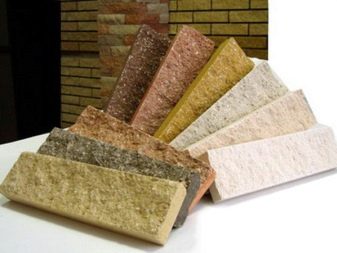

The surface of this material is extremely durable, therefore, when using it, you can not be afraid that the tile will break or deform. This makes the installation process simple and easy. After the work is over, it is easy to clean the finished masonry from dirt, dust and any dirt. The ability to absorb water allows you to protect the foundation and walls from moisture penetration, which entails the appearance of fungus.
It would seem that clinker tiles have only advantages, but there are also some nuances.
- If the slabs are located in a place where sharp and strong impacts are possible, then most likely they will deform and crack. It is better to mount them in areas that are not subject to strong mechanical stress.
- Another important factor that can influence your decision to buy clinker is its cost. This tile is much more expensive than ordinary tile, so not everyone can afford it.



If you nevertheless decide to buy clinker tiles, then you need to know that there are several options for it:
- technical... Used for arranging paths and sidewalks on the street;
- water resistant... Required at hydraulic facilities;
- facing... For carrying out external and internal repair work in the house.



The surface of such a tile can be either matte or smooth, and the variety of colors will allow you to embody any idea. There is even a difference in textures, so it is important to know exactly what you are planning to do, what end result you want to see. Then the choice of clinker tiles will become much easier.
The next material to talk about is gypsum, from which the tiles are made "under the brick". With this material you can decorate a bedroom or any other living room, and the effect will be pleasant... If the room has a fireplace, plaster is exactly what should frame it, highlight it in the interior.


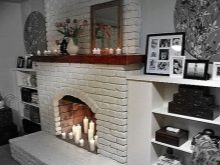
It is important that after installation there is no need to carry out additional work: the material is completely ready.
If you wish, you can highlight the texture of the brick using a color, for which it is enough just to paint the plaster surface in the shade you need.

Ordinary ceramic tiles can also be made under the brick. Thanks to the use of sand and clay in the right proportions, an environmentally friendly material is obtained that can be safely installed in any living space. In addition to finishing inside the house, you can use it outside.
The texture of the tile is smooth, because the wall, decorated in this way, turns out to be as similar as possible to a real brick one. The advantage of tiles is their ability to combine well with different surfaces. Combinations with wood or wallpaper will look interesting and unusualwhile making the space more harmonious. In this case, too, the color scheme can be any: both monochromatic and with stains or prints.


The choice of option depends on the taste of the person doing the renovation and on the general functional task of the room.
Another type of tile is polycement, which is made from crushed sand, cement and shells. The advantage of such a coating will be ease of installation, air permeability, surface texture.
Fragility is often highlighted among the minuses. Even transporting such tiles is problematic if the car is not equipped with sufficiently high-quality shock absorbers, or there are many holes on the road. During installation, you can easily break the "brick"... So, the amount of required material will increase significantly.

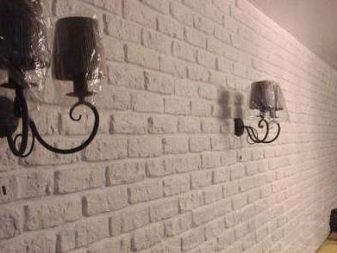
One of the modern materials is flexible tiles. For its manufacture, cement, acrylic polymer and pigment are taken. A feature of the material is the ability to bend it as the surface requires. It is easy to lay flexible tiles on round and semicircular construction objects. In order to achieve softness, you just need to warm it up. To do this, you can use a regular or construction hair dryer.
Flexible tiles as a finishing material have their own advantages:
- heat and sound insulation;
- simple installation, no special requirements for work;
- ease of construction;
- minimum garbage and waste after the working process;
- you do not need to buy a special solution for fastening: the tiles can be planted on cement;
- undemanding to environmental conditions, she is not afraid of temperature drops and humidity;
- flexible tiles have a pleasant texture, you want to touch them.



Among the disadvantages of this material, only one can be named - an extremely high price.
Color solutions
If you plan to decorate a room inside with a brick-like tile, then you need to decide not only on the type of this material, but on its color. The most common is the red and brown color scheme, which gives the impression of real brickwork right in your home. To give the interior lightness, it is best to use white.He will emphasize the objects that are in the room, and at the same time he will draw attention to himself.
Small rooms in this design will seem much larger, and with a well-planned arrangement of furniture and other objects, you can significantly expand the space.






An alternative is to contrast multiple colors. Part of the room can be made in one shade, and the other in the completely opposite. You can divide the space into top and bottom, and plan something specific, thematic for each part.
To create an interesting effect in the room, you can choose tiles of an unusual color, which will combine several colors. It can be brick red, brown and its tones, gray, beige or sandy. And:
- Red or brown tiles can be used in classic, English, American, French and Provence styles. The tile is used in the design of door and window spaces, for wall cladding.
- Fans of retro style need to pick up an artificial brick, on which there will be chips, gaps and other specially made flaws.
- White color and smooth texture are suitable for a modern high-tech style.
- Minimalism is also characterized by light colors and a small distance between the seams, which it is advisable not to highlight.






If you do not want to adhere to any one direction and style, then you can successfully combine color schemes. Accordingly, the choice of colors will depend on the stylistic orientation of the room in which the renovation is being made, as well as the tasks set by the designer.
However, it is also important to take into account the illumination of the space:
- For dark rooms, it is better to choose light options;
- in spacious and sunny rooms, you can not be afraid to make bright and sometimes dark color accents.
Black tiles are used infrequently, in small quantities. She can successfully shade the desired objects or areas.
Blue and white tiles will look great in the bathroom, but beige tiles will delight the inhabitants of the bedroom. The brown finish will be appropriate on the loggia, in the hall by the fireplace, in the corridor and in any areas where a person does not spend much time.




Dimensions (edit)
If you decide to make a brick finish at home, but you need to know what the sizes of the tile material are in order to correctly calculate the required amount. Regardless of the manufacturer, tiles of this kind can be found in only two formats:
- single elements;
- laid out rows.


As for the thickness, it depends on the texture of the product. The thickness can be from 8 to 14 mm when it comes to clinker or ceramic versions. For concrete tiles, the thickness can be up to 24 mm. In order for the decorative element to look as natural as possible, its dimensions are adjusted to a standard brick. So, the length of the plates is 25 cm, but the width can be different. If the brick is single, then the width will be 60 mm; if one and a half - 70 mm; for double bricks, it will be 120 mm.
Not everyone has the goal of imitating brick as such. Many people just like this finish, and therefore there is a series of products in non-standard sizes. These can be "bricks" with dimensions of 240x52 mm or 240x88 mm... In order for the tile to fit perfectly into your living space, calculate its dimensions, decide which option in length and width will be optimal for you, and at what dimensions you can quickly lay out the tiles.

It is important to plan your masonry so that you have as little clippings and debris as possible. This will significantly save your renovation budget.
Manufacturers overview
In order for the repair to be successful and the result to please you, it is important to choose a good and high-quality product. There is a huge selection of various tiles on the market now, and it can be difficult to navigate with all this variety.In this regard, it is worth considering the best manufacturers whose products are popular today. Among them are enterprises from Spain, Ukraine and Italy.

Ukrainian tiles are represented in the world by such companies as Golden Tile, Inter Cerama, Zeus Ceramica and Atem. The tile design of any company is distinguished by originality and fresh solutions, and the high quality of raw materials from which building materials are produced puts them on a par with world brands. Technological equipment is improved every year, which allows the quality of products to grow, so that they remain competitive all the time.
Golden Tile Company located in Kharkov. It accounts for about 30% of all produced porcelain stoneware in the country. It has its own raw material base, good and high-quality equipment, the best designers with vast experience. Each type of product must meet high quality standards, while the cost of goods remains optimal.



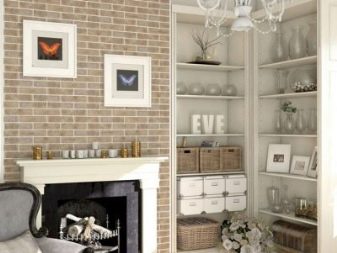
If we consider the Dnipropetrovsk Inter Cerama, then you can find out that she uses the technologies of Spanish and Italian industries, trying to match them in everything. The work uses the highest grade of clay, on the basis of which all products are made. Here they make floor, wall tiles, options for kitchens, bathrooms, living rooms. The collections "under the wood", "under the marble" and "under the natural stone" stand out especially.



Any company aims to give the buyer what he is looking for. Any whim, design decision, invention must be foreseen and satisfied so that the demand for products remains stable. It is according to these principles that Ukrainian companies work, successfully distributing their products far beyond the borders of their native state.
Next is Spain. It is in this country that the highest quality tiles and porcelain stoneware are produced. Spanish standards have long been considered reference, and everyone who wants to achieve high quality of their products, long service life, and originality of decorative solutions are equal to them. The products of Spanish brands are installed in expensive hotels, in luxury apartments, in simple apartments owned by people who know what art is.



Spanish tiles can decorate any room in the house, adding variety with the help of an unusual texture and pleasant pattern.
The most popular companies are Absolut Keramica, Albaidar, Alcalaten Ceramicas, Alnera Ceramica and many others. You can find the products of these brands in specialized stores and salons, where you can also get acquainted with the main characteristics of each of them in more detail.



Everyone's favorite is Italian tiles. It is she who has been for many centuries is an invariable attribute of style and quality... Traditions that are so honored in Italy help to create masterpieces of design ideas based on modern technologies. Years of experience and state-of-the-art developments represent a striking combination that allows Italy to maintain a leading position in the ceramic tile industry worldwide.
The product features the following characteristics:
- facing tiles have high moisture resistance;
- outdoor options are wear-resistant;
- clinker tiles are frost-resistant and heat-resistant;
- porcelain stoneware is not inferior to natural stone;
- stone, glass, ceramic mosaics are produced. There are even specimens of precious stones.




Italian tiles are renowned for their durability as they are fired twice. This makes it even stronger than reinforced concrete. T
Also, the products are characterized by high rigidity, due to which it does not deform under any circumstances... Fireproof characteristics allow these materials to be used near sources of fire: fireplace or stove. They also monitor compliance with all environmental standards of products so that they do not emit any poisonous and harmful substances. Due to moisture resistance, you can not be afraid of electric shock... In addition, the structure of the material does not change when exposed to water or detergents.

The most popular companies are Atlas Concorde, Imola other. As for the products of the first company, they are distinguished by high aesthetics. This allows the tiles to be used both in ordinary apartments and in large-scale public buildings.
The tiles of the second brand are characterized by the use of the Color Definition System technology in their production. This makes it possible to apply amazing graphic objects to ceramic specimens.



How to choose?
If you decide to use brick-like tiles in the interior of your home, you should think about which option is better to choose, what you need to pay attention to. Not everyone shares the opinion that the use of such material for interior decoration is right and beautiful, and in inept hands it really is. However, if you place all the elements in their places, placing the accents correctly, then your room will sparkle with new colors, acquire a completely different character.
To decorate a certain room, you need the right material, and you will have to choose between clinker and gypsum tiles. Clinker room is used more often as a facade, but you can also find it indoors. With its help, you can make a spectacular accent on the fireplace or stove, if there are such items in the house.
Depending on the size, lighting and general design of the room, you can choose either options in neutral shades, or bright and colored.


It is important to order clinker "bricks" from one collection, one batch, one issue. Otherwise, the same look may be of a different color, texture, differ in any other small details that will be noticeable after installation. It is best to order tiles in a trusted place or from a well-known company in order to know for sure that the quality of the products will be excellent, and your repair will remain relevant for many years.
The color and texture of porcelain stoneware should match the place where it will be placed, and go well with the materials that are already in the room, if you are not going to change them. In the case of tiles, it is better not to save money, but to buy a high-quality one for a moderately high price. A cheap one will last much less, and difficulties may arise during the installation process.

For the hallway, you can use options for a variety of colors and textures, since this room does not carry a large semantic load. The same cannot be said about the living room, where there are always a lot of people. Here it is important to please all family members by creating a pleasant and cozy indoor atmosphere. If the living room can literally be covered with brick-like tiles, then in other rooms it is recommended to set aside only one wall for this, focusing on it.
Ceramic tiles are one of the most affordable and popular. It is used to decorate the entire room, such as a bathroom or kitchen. You can partially decorate the room by using ceramics to decorate a fireplace or a kitchen apron. In the second case, it is important to use only refractory material so that it is strong enough. This is due to the thermal effect on it. Polymer cement tiles are inexpensive, quick and easy to work with... Due to the low quality, such material cannot be used everywhere. The color variety is not too large, as well as the textured variety, but if you wish, you can always find something suitable.



As for the brick-like plaster tiles, this option is very fragile, and therefore only a professional can work with it. Among the advantages, one can note the light weight of the "bricks", the convenience of working with them, provided that they are handled carefully. This material looks beautiful in the interior. "Native" color - white, but in the process of renovation, you can paint the finished wall in any shadewhichever you like, or one that matches the style of the room.
If you can choose the material for your premises on your own, then the process of preparing for the repair and he himself will pass quickly, giving pleasure. In the event that you are having difficulties, it is better to ask a professional for advice. It is advisable to think over all possible difficulties in advance in order to minimize the risk of their occurrence.

Care Tips
Any covering that is installed in the house needs care, cleaning or cleaning. In order not to spoil the decorative brickwork, you need to know how to care for it. Different materials require different maintenance methods. Almost all types of tiles require cleaning, which is done by dry and wet methods. It is important not to allow moisture to get on the "bricks", as this negatively affects the properties of the coating.
Wipe off the dust layer with a damp cloth is the most correct way to care for the surface. After such cleaning, the tile is wiped with a dry cloth so that it becomes completely dry. Another cleaning method is used only for materials originally laid out in bathrooms or near a sink in the kitchen, since moisture is not at all terrible for them.


If dirt gets on the decorative coating, you need to deal with it immediately, otherwise, when it dries, it will eat into the surface, and it will be impossible to clean it off.
Do not use aggressive cleaning agents, because the abrasive structure and active chemicals will destroy the integrity of the product surface. If the installation is done correctly, then it is much easier to clean the walls or parts of them with decorative brickwork. Dirt and dust do not remain in the grooves and joints and can be easily removed with a dry or damp cloth.

Beautiful examples in the interior
Depending on what exactly you want to see in your home, you can use not only different materials stylized as a brick, but also use stylistic techniques. So, the loft style allows you to partially or completely decorate the room with brickwork, which creates a unique image.

A living room or hall looks best if you select only one wall with the help of masonry, and decorate the rest either with a different color, but with the same materials, or mix the tiles with wallpaper or paint. Furniture in such an interior should be expressive, create a kind of color spot in a fairly uniform space.

For the kitchen, for example, it would be quite appropriate and interesting to use tiles throughout the room. The loft style here creates a unique atmosphere, gives a feeling of warmth and comfort, which is quite difficult with bare brick walls.

Laying brick-like tiles in the corridor is a fairly common technique, and therefore different colors and textures can be used indoors. Since the corridor is often a poorly lit area, it is best to choose light tiles with an interesting texture. So you can make the space more voluminous, the room more spacious. To add originality, unfinished masonry can be used, thereby separating the dressing area and the rest of the corridor.

Brick-like tiles are rarely used to decorate a bedroom. Usually, a brick wall is made alone, placing a sleeping place on its background to emphasize its importance. In view of this location, this decor element does not interfere in any way with a good rest. In whatever style you decide to make your bedroom, you will definitely not ruin it with brickwork.
The main thing is to correctly enter such an element, as well as guess with the number of tiles. The color scheme can be any: from natural brick color to white and beige.

Complementing the interior design with decorative brick-like tiles is an interesting and versatile solution suitable for those who want to create a cozy, but at the same time dynamic environment.
For information on how to make a brick tile with your own hands, see the next video.













The comment was sent successfully.